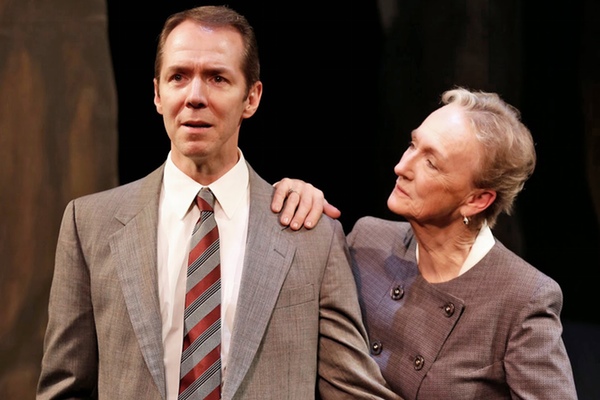Eliminating Nukes with a Walk in the Woods?

It is 1982 in Geneva, Switzerland, at the height of the Cold War, and two diplomats, John Honeyman from the United States and Irina Botvinnik of the Soviet Union, walk through the woods outside the city and fall into a conversation on how to re-write a nuclear arms reduction treaty between their two countries. Back home, the Americans are verbally battering the Soviets and the Soviets are hammering the Americans. All looks bleak.
What does happen in those secret behind-closed-doors diplomatic talks? Do negotiators go for a walk in the wood and settle things? That is the theme of A Walk in the Woods, the revival of a 1988 play be Lee Blessing, which opened last week at the Clurman Theater, Theater Row, New York.
The play is not interesting for what is says about life in 1988, but about how world politics have changed so dramatically since then. Today, those same two diplomats would not just be discussing a single nuclear arms treaty between their two countries, but all of the political eruptions sweeping the world today. Libya. Egypt. Ukraine, China, Israel. North Korea. The Middle East (choose a villain – ISIS, the Taliban, Al Qaeda). The pair would have their heads spinning today.
And that is the problem with A Walk in the Woods, a fine play with a nice subplot about how the two enemies become friends and strive to end the Cold War. Now, the tension is gone. The Soviet Union fell in 1991 and many countries were carved out of it. The Russians still have nuclear missiles, lots of them, and so do we, but no one seems to think either side would launch them. The fear now is a nuclear bomb of some kind being exploded by terrorists (pick any of a dozen groups).
Whatever tension there was in the 1988 play is lost now. The pair is not really racing a deadline, with nuclear silos opening all over the world. The idea that there is no hope, as Irina suggests often, is not believable today.
And the pair rambles in their conversations. This is one theme play and with just two actors there is not much room for sub plots besides the growing friendship between the pair. There are long moments of dull conversation and the arguments are as quiet as the huge trees that surround them.
The play gets remarkably better, though, as it goes on as the two diplomats reach a new agreement that they think they can sell to their country’s leaders. It is a break through. That plan changes the demeanor of each and their friendship grows.
The question in the play, of course, is whether two diplomats sitting on a bench in a forest can change the world. Can they do it with many conversations in the woods or do they need atomic bombs in their hands? Or Bibles?
The play is ever hopeful. The two talk about rational thinking and trace the nuclear arms race back to the end of World War II. Each claims that his/her side will denounce whatever treaty the other proposes. Irina scornfully tells John that it has always been this way and always will be. In the end, she says, the Kremlin will reject the perfect treaty just because the Americans wrote it.
Of course Blessing, nobody, could have predicted that it would not be the United States that toppled the Soviet Union, but a political movement within its borders.
A real strength of the play is the acting by Paul Niebanck as Honeyman and Kathleen Chalfant as Irina. Chalfant is especially good at leaping back from tough negotiator to charming friend.
The play does explore nuclear history. By 1982, when the play takes place, the two superpowers had met numerous times to disarm each other. The first major meeting was in the early sixties and that resulted in two Nuclear Test Ban treaties. Following that were more sets of talks and treaties, including the Strategic Arms Limitation Talks treaty, 1979, the Nuclear Forces Treaty (1987) and the START I treaty of 1991. The START treaty of 1999 was followed by the Strategic Offensive Reduction Talks treaty of 2003. Another treaty was signed in 2010. That one will hopefully lead to just a few thousands missiles on each side, down from nearly 34,000 at the height of the old War.
PRODUCTION: The play was produced by Keen Company. Sets: Scott Bradley, Costumes: Amanda Jenks and Jennifer Paar, Sound: M.I. Dogg, Lighting: Josh Bradford. The play was directed by Jonathan Silverstein. It runs through October 18.